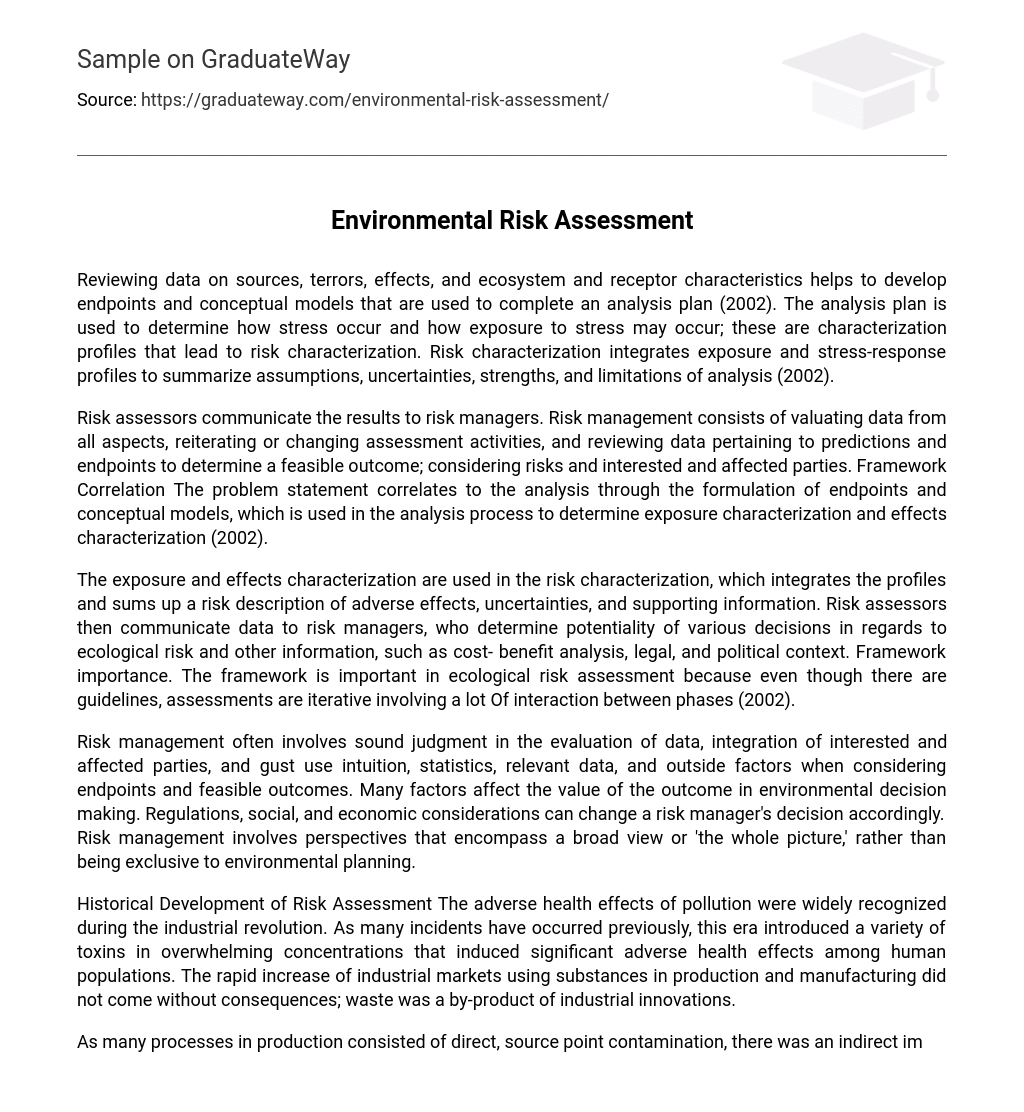Reviewing data on sources, terrors, effects, and ecosystem and receptor characteristics helps to develop endpoints and conceptual models that are used to complete an analysis plan (2002). The analysis plan is used to determine how stress occur and how exposure to stress may occur; these are characterization profiles that lead to risk characterization. Risk characterization integrates exposure and stress-response profiles to summarize assumptions, uncertainties, strengths, and limitations of analysis (2002).
Risk assessors communicate the results to risk managers. Risk management consists of valuating data from all aspects, reiterating or changing assessment activities, and reviewing data pertaining to predictions and endpoints to determine a feasible outcome; considering risks and interested and affected parties. Framework Correlation The problem statement correlates to the analysis through the formulation of endpoints and conceptual models, which is used in the analysis process to determine exposure characterization and effects characterization (2002).
The exposure and effects characterization are used in the risk characterization, which integrates the profiles and sums up a risk description of adverse effects, uncertainties, and supporting information. Risk assessors then communicate data to risk managers, who determine potentiality of various decisions in regards to ecological risk and other information, such as cost- benefit analysis, legal, and political context. Framework importance. The framework is important in ecological risk assessment because even though there are guidelines, assessments are iterative involving a lot Of interaction between phases (2002).
Risk management often involves sound judgment in the evaluation of data, integration of interested and affected parties, and gust use intuition, statistics, relevant data, and outside factors when considering endpoints and feasible outcomes. Many factors affect the value of the outcome in environmental decision making. Regulations, social, and economic considerations can change a risk manager’s decision accordingly. Risk management involves perspectives that encompass a broad view or ‘the whole picture,’ rather than being exclusive to environmental planning.
Historical Development of Risk Assessment The adverse health effects of pollution were widely recognized during the industrial revolution. As many incidents have occurred previously, this era introduced a variety of toxins in overwhelming concentrations that induced significant adverse health effects among human populations. The rapid increase of industrial markets using substances in production and manufacturing did not come without consequences; waste was a by-product of industrial innovations.
As many processes in production consisted of direct, source point contamination, there was an indirect impact on the community. Air pollution, water contamination, soil contamination, and ecological degradation Were the beginning of detrimental health effects in humans and other living organisms. The increase in specific diseases followed by morbidity, leading to eventual mortality, was recognized by physicians in the medical field. Reproductive and developmental concerns grew as physicians inquired about toxicology within the scientific community.
Research and studies proved waste by-products were contaminating food, water, air, and soil resources that had adverse health effects on workers and citizens in the community, with an emphasis on children and pregnant women. Efforts to stop waste dumping and to regulate waste disposal and water pollution started early on and scientists discover a significant increase n cancer in chimney sweeps from coal (2002). Physicians and scientists began writing publications on the adverse health effects observed in practice to establish awareness in the general public and to inform regulators of adverse health effects in the community.
The first scientific inquiry’ about infectious disease, child mortality, and the link to polluted water supplies and lack of sanitation was written by Edwin Chadwick in 1842 (2002). As physicians and scientist’s document observations and findings, authorities begin to take notice and initiate regulations relative to pollution, occupational disease, and there contamination and health issues. As Louis Pasteur germ theory (2002) revolutionizes public health, more regulations begin to emerge in the boards of health (2002).
Although risk assessment has evolved considerably since the industrial revolution, many ecological risk assessment (ERA) techniques have been adopted from human health risk assessment (HRS) methodologies. The fundamental differences between an ecosystem and human health are the sole receptor of a human, an exclusive species that does not begin to encompass the systematic nature of an ecosystem. An innovative approach is he integration of the fields of ecology and ERA to develop a more holistic approach to ERAS that stimulates the structure and dynamics of complex ecological networks (2006).
Another innovative approach to ERA is qualitative and decision independent assessments that do not necessarily influence risk manager’s decisions but assist in developing a consensus among stakeholders concerning goals and priorities (2008). The legal and political challenges are often restrictive in regulatory demands; however, risk management reaches beyond the scope of environmental planning to include takeovers’ decisions as well as economics, social, and ecological context.





